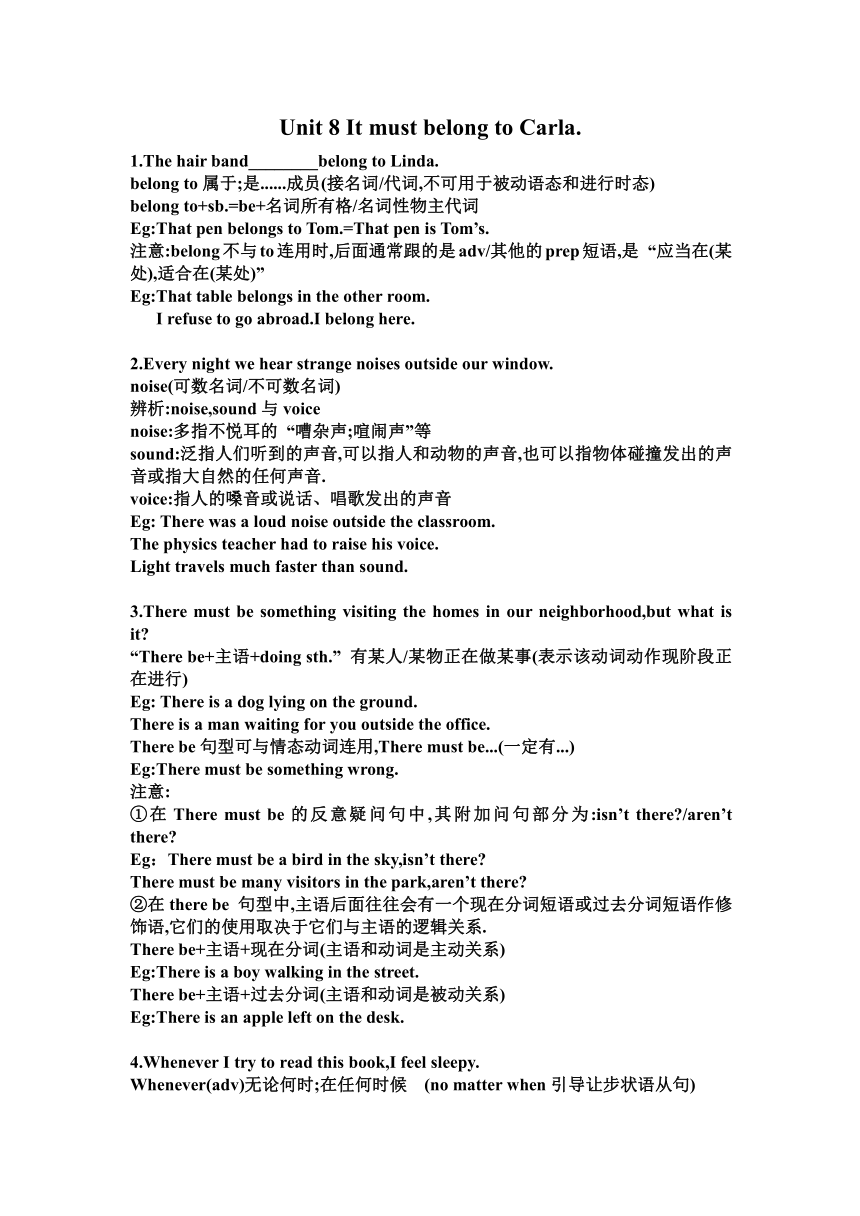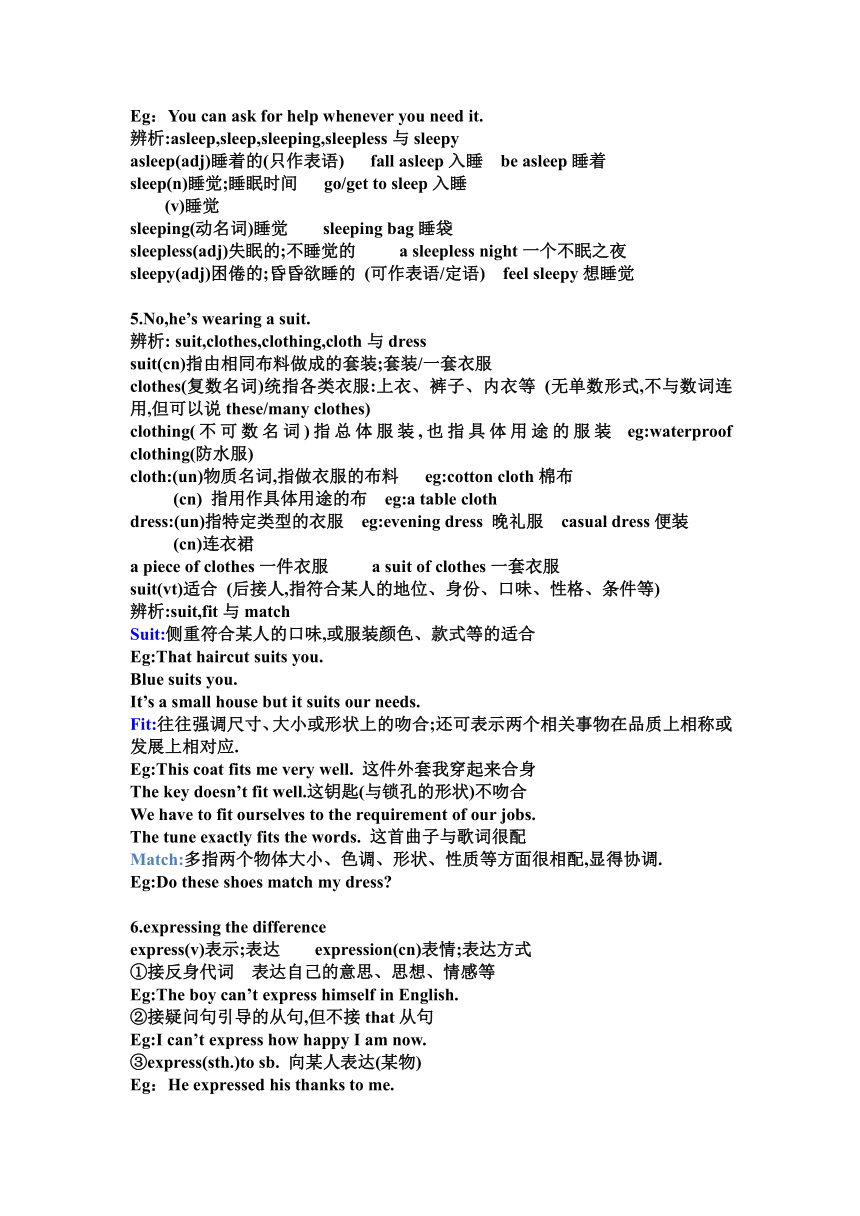Unit 8 It must belong to Carla 知识点讲义
文档属性
| 名称 | Unit 8 It must belong to Carla 知识点讲义 |  | |
| 格式 | docx | ||
| 文件大小 | 23.6KB | ||
| 资源类型 | 教案 | ||
| 版本资源 | 人教新目标(Go for it)版 | ||
| 科目 | 英语 | ||
| 更新时间 | 2024-01-11 21:08:51 | ||
图片预览


文档简介
Unit 8 It must belong to Carla.
1.The hair band________belong to Linda.
belong to属于;是......成员(接名词/代词,不可用于被动语态和进行时态)
belong to+sb.=be+名词所有格/名词性物主代词
Eg:That pen belongs to Tom.=That pen is Tom’s.
注意:belong不与to连用时,后面通常跟的是adv/其他的prep短语,是 “应当在(某处),适合在(某处)”
Eg:That table belongs in the other room.
I refuse to go abroad.I belong here.
2.Every night we hear strange noises outside our window.
noise(可数名词/不可数名词)
辨析:noise,sound与voice
noise:多指不悦耳的 “嘈杂声;喧闹声”等
sound:泛指人们听到的声音,可以指人和动物的声音,也可以指物体碰撞发出的声音或指大自然的任何声音.
voice:指人的嗓音或说话、唱歌发出的声音
Eg: There was a loud noise outside the classroom.
The physics teacher had to raise his voice.
Light travels much faster than sound.
3.There must be something visiting the homes in our neighborhood,but what is it
“There be+主语+doing sth.” 有某人/某物正在做某事(表示该动词动作现阶段正在进行)
Eg: There is a dog lying on the ground.
There is a man waiting for you outside the office.
There be句型可与情态动词连用,There must be...(一定有...)
Eg:There must be something wrong.
注意:
①在There must be的反意疑问句中,其附加问句部分为:isn’t there /aren’t there
Eg:There must be a bird in the sky,isn’t there
There must be many visitors in the park,aren’t there
②在there be 句型中,主语后面往往会有一个现在分词短语或过去分词短语作修饰语,它们的使用取决于它们与主语的逻辑关系.
There be+主语+现在分词(主语和动词是主动关系)
Eg:There is a boy walking in the street.
There be+主语+过去分词(主语和动词是被动关系)
Eg:There is an apple left on the desk.
4.Whenever I try to read this book,I feel sleepy.
Whenever(adv)无论何时;在任何时候 (no matter when引导让步状语从句)
Eg:You can ask for help whenever you need it.
辨析:asleep,sleep,sleeping,sleepless与sleepy
asleep(adj)睡着的(只作表语) fall asleep入睡 be asleep睡着
sleep(n)睡觉;睡眠时间 go/get to sleep入睡
(v)睡觉
sleeping(动名词)睡觉 sleeping bag睡袋
sleepless(adj)失眠的;不睡觉的 a sleepless night一个不眠之夜
sleepy(adj)困倦的;昏昏欲睡的 (可作表语/定语) feel sleepy想睡觉
5.No,he’s wearing a suit.
辨析: suit,clothes,clothing,cloth与dress
suit(cn)指由相同布料做成的套装;套装/一套衣服
clothes(复数名词)统指各类衣服:上衣、裤子、内衣等 (无单数形式,不与数词连用,但可以说these/many clothes)
clothing(不可数名词)指总体服装,也指具体用途的服装 eg:waterproof clothing(防水服)
cloth:(un)物质名词,指做衣服的布料 eg:cotton cloth棉布
(cn) 指用作具体用途的布 eg:a table cloth
dress:(un)指特定类型的衣服 eg:evening dress 晚礼服 casual dress便装
(cn)连衣裙
a piece of clothes一件衣服 a suit of clothes一套衣服
suit(vt)适合 (后接人,指符合某人的地位、身份、口味、性格、条件等)
辨析:suit,fit与match
Suit:侧重符合某人的口味,或服装颜色、款式等的适合
Eg:That haircut suits you.
Blue suits you.
It’s a small house but it suits our needs.
Fit:往往强调尺寸、大小或形状上的吻合;还可表示两个相关事物在品质上相称或发展上相对应.
Eg:This coat fits me very well. 这件外套我穿起来合身
The key doesn’t fit well.这钥匙(与锁孔的形状)不吻合
We have to fit ourselves to the requirement of our jobs.
The tune exactly fits the words. 这首曲子与歌词很配
Match:多指两个物体大小、色调、形状、性质等方面很相配,显得协调.
Eg:Do these shoes match my dress
6.expressing the difference
express(v)表示;表达 expression(cn)表情;表达方式
①接反身代词 表达自己的意思、思想、情感等
Eg:The boy can’t express himself in English.
②接疑问句引导的从句,但不接that从句
Eg:I can’t express how happy I am now.
③express(sth.)to sb. 向某人表达(某物)
Eg:He expressed his thanks to me.
Every year it receives more than 750,000 visitors.
receive(vt)接受;收到 (receive sth. from sb.收到来自某人的某物)
辨析:receive与accept
receive:(客观上)收到 (不强调主观意愿上是否接受或同意)
accept:(主观上)收到 (强调主观意愿,如接受邀请或建议等)
Eg:I received a gift from my friend,but I didn’t accept it in the end.
receive(vt)接待;欢迎;招待 (通常接sb.)
Eg:She isn’t well enough to receive visitors.
People like to go to this place especially in June as they want to see the sun rising on the longest day of the year.(人们尤其喜欢六月去那里,因为他们想在一年中白昼最长的一天看日出)
as(conj)因为;由于(引导原因状语从句)
辨析:because,since与as
because:用来回答why的提问
since:语气较because弱较as强 表示显然的或对方已知的原因,即对已知事实提供理由 (引导的原因状语从句一般位于主句的前面)
as:语气较since弱 从句说明原因,主句说明结果.表示十分明显或对方已知的原因,常用于口语
Eg:We had to stay at home because it rained.
Since you are busy,I won’t bother you.
As I am leaving tomorrow,I’ve bought you a present.
9.They think the stones can prevent illness and keep people healthy.
prevent(vt)阻止;阻挠 ~sb.from doing sth.阻止某人做某事
stop...from doing sth. keep...from doing sth.阻止做某事
keep sb./sth.+adj 使某人/某物保持某种状态 (keep+宾语+补足语结构)
Eg:The coat will keep you warm.
I’m sorry to keep you waiting.
He kept his coat on.
情态动词表示推测
1.对不同时段发生的事情的推测表示方法
对...的推测 表示方法
现在的事情 情态动词+动原
正在发生的事情 情态动词+be+doing
过去的事情 情态动词+have+过去分词
在不同句型中的推测表示放法
①在肯定句中
表示推测的情态动词的程度
弱_________________强
might→may→could→can→must
(表示可能性的大小程度)
②在否定句中
can’t/couldn’t:表示有把握的否定推测 (不可能) couldn’t的语气较can’t委婉
may not/mightn’t:表示不太有把握的否定推测 (可能不)
③在疑问句中
在疑问句中表示推测的情态动词,一般只用can/could(可能;会)
Eg: Can it be true
注意:把含有must be的句子变为否定句时,需把must be 改成can’t be
Eg:We must be wrong. We can’t be wrong.我们不可能搞错了.
表示推测时,反义疑问句的两种情况
①陈述部分是对现在的状态(现在的事实)进行推测时,反义疑问句部分用现在时态
Eg: They could be working at the hospital,aren’t they
②陈述部分是对过去发生的事情进行推测,若有表示过去的时间状语,反义疑问句用一般过去时;若无表示过去的时间状语,反义疑问句部分用现在完成时
Eg: You might have been to Summer Palace,haven’t you
It must have rained last night,didn’t it
1.The hair band________belong to Linda.
belong to属于;是......成员(接名词/代词,不可用于被动语态和进行时态)
belong to+sb.=be+名词所有格/名词性物主代词
Eg:That pen belongs to Tom.=That pen is Tom’s.
注意:belong不与to连用时,后面通常跟的是adv/其他的prep短语,是 “应当在(某处),适合在(某处)”
Eg:That table belongs in the other room.
I refuse to go abroad.I belong here.
2.Every night we hear strange noises outside our window.
noise(可数名词/不可数名词)
辨析:noise,sound与voice
noise:多指不悦耳的 “嘈杂声;喧闹声”等
sound:泛指人们听到的声音,可以指人和动物的声音,也可以指物体碰撞发出的声音或指大自然的任何声音.
voice:指人的嗓音或说话、唱歌发出的声音
Eg: There was a loud noise outside the classroom.
The physics teacher had to raise his voice.
Light travels much faster than sound.
3.There must be something visiting the homes in our neighborhood,but what is it
“There be+主语+doing sth.” 有某人/某物正在做某事(表示该动词动作现阶段正在进行)
Eg: There is a dog lying on the ground.
There is a man waiting for you outside the office.
There be句型可与情态动词连用,There must be...(一定有...)
Eg:There must be something wrong.
注意:
①在There must be的反意疑问句中,其附加问句部分为:isn’t there /aren’t there
Eg:There must be a bird in the sky,isn’t there
There must be many visitors in the park,aren’t there
②在there be 句型中,主语后面往往会有一个现在分词短语或过去分词短语作修饰语,它们的使用取决于它们与主语的逻辑关系.
There be+主语+现在分词(主语和动词是主动关系)
Eg:There is a boy walking in the street.
There be+主语+过去分词(主语和动词是被动关系)
Eg:There is an apple left on the desk.
4.Whenever I try to read this book,I feel sleepy.
Whenever(adv)无论何时;在任何时候 (no matter when引导让步状语从句)
Eg:You can ask for help whenever you need it.
辨析:asleep,sleep,sleeping,sleepless与sleepy
asleep(adj)睡着的(只作表语) fall asleep入睡 be asleep睡着
sleep(n)睡觉;睡眠时间 go/get to sleep入睡
(v)睡觉
sleeping(动名词)睡觉 sleeping bag睡袋
sleepless(adj)失眠的;不睡觉的 a sleepless night一个不眠之夜
sleepy(adj)困倦的;昏昏欲睡的 (可作表语/定语) feel sleepy想睡觉
5.No,he’s wearing a suit.
辨析: suit,clothes,clothing,cloth与dress
suit(cn)指由相同布料做成的套装;套装/一套衣服
clothes(复数名词)统指各类衣服:上衣、裤子、内衣等 (无单数形式,不与数词连用,但可以说these/many clothes)
clothing(不可数名词)指总体服装,也指具体用途的服装 eg:waterproof clothing(防水服)
cloth:(un)物质名词,指做衣服的布料 eg:cotton cloth棉布
(cn) 指用作具体用途的布 eg:a table cloth
dress:(un)指特定类型的衣服 eg:evening dress 晚礼服 casual dress便装
(cn)连衣裙
a piece of clothes一件衣服 a suit of clothes一套衣服
suit(vt)适合 (后接人,指符合某人的地位、身份、口味、性格、条件等)
辨析:suit,fit与match
Suit:侧重符合某人的口味,或服装颜色、款式等的适合
Eg:That haircut suits you.
Blue suits you.
It’s a small house but it suits our needs.
Fit:往往强调尺寸、大小或形状上的吻合;还可表示两个相关事物在品质上相称或发展上相对应.
Eg:This coat fits me very well. 这件外套我穿起来合身
The key doesn’t fit well.这钥匙(与锁孔的形状)不吻合
We have to fit ourselves to the requirement of our jobs.
The tune exactly fits the words. 这首曲子与歌词很配
Match:多指两个物体大小、色调、形状、性质等方面很相配,显得协调.
Eg:Do these shoes match my dress
6.expressing the difference
express(v)表示;表达 expression(cn)表情;表达方式
①接反身代词 表达自己的意思、思想、情感等
Eg:The boy can’t express himself in English.
②接疑问句引导的从句,但不接that从句
Eg:I can’t express how happy I am now.
③express(sth.)to sb. 向某人表达(某物)
Eg:He expressed his thanks to me.
Every year it receives more than 750,000 visitors.
receive(vt)接受;收到 (receive sth. from sb.收到来自某人的某物)
辨析:receive与accept
receive:(客观上)收到 (不强调主观意愿上是否接受或同意)
accept:(主观上)收到 (强调主观意愿,如接受邀请或建议等)
Eg:I received a gift from my friend,but I didn’t accept it in the end.
receive(vt)接待;欢迎;招待 (通常接sb.)
Eg:She isn’t well enough to receive visitors.
People like to go to this place especially in June as they want to see the sun rising on the longest day of the year.(人们尤其喜欢六月去那里,因为他们想在一年中白昼最长的一天看日出)
as(conj)因为;由于(引导原因状语从句)
辨析:because,since与as
because:用来回答why的提问
since:语气较because弱较as强 表示显然的或对方已知的原因,即对已知事实提供理由 (引导的原因状语从句一般位于主句的前面)
as:语气较since弱 从句说明原因,主句说明结果.表示十分明显或对方已知的原因,常用于口语
Eg:We had to stay at home because it rained.
Since you are busy,I won’t bother you.
As I am leaving tomorrow,I’ve bought you a present.
9.They think the stones can prevent illness and keep people healthy.
prevent(vt)阻止;阻挠 ~sb.from doing sth.阻止某人做某事
stop...from doing sth. keep...from doing sth.阻止做某事
keep sb./sth.+adj 使某人/某物保持某种状态 (keep+宾语+补足语结构)
Eg:The coat will keep you warm.
I’m sorry to keep you waiting.
He kept his coat on.
情态动词表示推测
1.对不同时段发生的事情的推测表示方法
对...的推测 表示方法
现在的事情 情态动词+动原
正在发生的事情 情态动词+be+doing
过去的事情 情态动词+have+过去分词
在不同句型中的推测表示放法
①在肯定句中
表示推测的情态动词的程度
弱_________________强
might→may→could→can→must
(表示可能性的大小程度)
②在否定句中
can’t/couldn’t:表示有把握的否定推测 (不可能) couldn’t的语气较can’t委婉
may not/mightn’t:表示不太有把握的否定推测 (可能不)
③在疑问句中
在疑问句中表示推测的情态动词,一般只用can/could(可能;会)
Eg: Can it be true
注意:把含有must be的句子变为否定句时,需把must be 改成can’t be
Eg:We must be wrong. We can’t be wrong.我们不可能搞错了.
表示推测时,反义疑问句的两种情况
①陈述部分是对现在的状态(现在的事实)进行推测时,反义疑问句部分用现在时态
Eg: They could be working at the hospital,aren’t they
②陈述部分是对过去发生的事情进行推测,若有表示过去的时间状语,反义疑问句用一般过去时;若无表示过去的时间状语,反义疑问句部分用现在完成时
Eg: You might have been to Summer Palace,haven’t you
It must have rained last night,didn’t it
同课章节目录
- Unit 1 How can we become good learners.
- Section A
- Section B
- Unit 2 I think that mooncakes are delicious!
- Section A
- Section B
- Unit 3 Could you please tell me where the restroom
- Section A
- Section B
- Unit 4 I used to be afraid of the dark.
- Section A
- Section B
- Unit 5 What are the shirts made of?
- Section A
- Section B
- Review of Units 1-5
- Unit 6 When was it invented?
- Section A
- Section B
- Unit 7 Teenagers should be allowed to choose their
- Section A
- Section B
- Unit 8 It must belong to Carla.
- Section A
- Section B
- Unit 9 I like music that I can dance to.
- Section A
- Section B
- Unit 10 You're supposed to shake hands.
- Section A
- Section B
- Review of Units 6-10
- Unit 11 Sad movies make me cry.
- Section A
- Section B
- Unit 12 Life is full of the unexpected
- Section A
- Section B
- Unit 13 We're trying to save the earth!
- Section A
- Section B
- Unit 14 I remember meeting all of you in Grade 7.
- Section A
- Section B
- Review of Units 11-14
